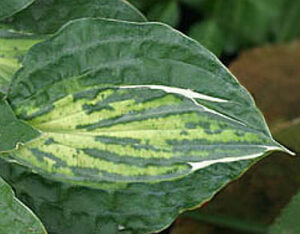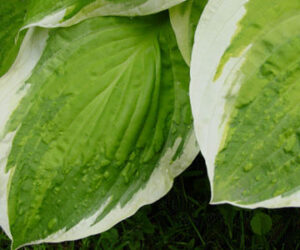
How to Identify HVX – Hosta Virus X
September 1, 2023
“Oooh, that’s such a unique hosta!” Beware. Unusual markings on hosta leaves may be a serious disease known as HVX.
Hosta viruses have been known to exist since at least 1985. Dr. Ben Lockhart of the University of Minnesota, the leading researcher on viruses in hostas and first to isolate Hosta Virus X (HVX), found four different viruses that are pathogens for hosta. Dr. Lockhart concluded that plants cannot be cured of viruses, so the best remedy is for any hosta exhibiting a virus to be destroyed.
Increasingly, virused hostas are showing up in large general nurseries and “box” stores that sell plants to the public on a large scale. The increase appears to be due to mass propagation of hostas infected with the virus, also allowing the virus to be propagated with the plants.
Read on for more information about HVX.
What Do Hosta HVX Symptoms Look Like?
Normal symptoms of viruses include:
Inkbleed — Ink bleed is a darker discoloration that typically occurs in the veins of a hosta and is among the most common symptoms of HVX.

Tissue Collapse — More heavily infected hostas often show tissue that appears gnarled and irregular and may be accompanied by discoloration.

Mottling – Mottled tissue or flecks on the leaves can sometimes be a symptom of HVX, but can also be a symptom of other types of virus. When in doubt, throw it out.

How Does HVX Spread to Other Hostas?
HVX is most often spread by the sap of an infected plant coming in contact with an open wound in a clean plant. This can be from tools that were not disinfected between use in dividing plants, or pruning tools used to cut the scapes from different plants without disinfecting them between use. In mass cultivation, harvesting machines can transfer the disease.
If a plant with HVX is cultivated through tissue culture, the entire batch will likely be infected.
The virus also may have the potential to spread from an animal or insect feeding on an infected plant, then feeding on another plant.
Common Hostas with Hosta Virus X
HVX, has been seen in many hostas in bareroot stock purchased from overseas, but is now becoming pervasive in American gardens . . . especially in plants of ‘Sum and Substance’ and ‘Gold Standard’. Other Hostas with the virus include ‘Golden Tiara’, ‘Wide Brim’, ‘Birchwood Parky’s Gold’, ‘Diamond Tiara’, ‘Striptease’ and many others. This is not to say that these plants are the culprits, rather that these plants most often exhibit the virus. If they are being purchased, they should be carefully inspected beforehand.
That said, viruses may lay dormant and may not exhibit symptoms for years. A best practice is to purchase hostas from a reputable grower and to ask where their nursery stock originates from. Even notable brands, unfortunately, have distributed infected stock.
What to Do if You Suspect HVX
The American Hosta Growers Association recommends that its members do the following if they receive hostas that appear to have the virus:
- Never share an infected plant.
- Remove and discard diseased plants in the trash — do not compost.
- Thoroughly disinfect any tools that came in contact with infected plant materials in a 10% bleach solution.
- Do not plant another hosta in the same place for a minimum of three years. Other plants can, however, be planted in the area.
- Observe nearby hostas that may have come in contact with the diseased plant for symptoms. To be on the safe side, do not share hostas grown nearby to help prevent potential spread.
- Notify your supplier if you received infected plants and ask for your money back. Share a photo of your hosta showing HVX symptoms to help prove your case. The more complaints, the more pressure can be brought to help get this problem under control.
Is there an HVX Test?
Clear symptoms are often enough to confirm the presence of HVX. However, if you’re unsure and suspect you have an infected plant, there are test strips available online from Agdia. Various plant disease diagnostic clinics or laboratories may also offer testing services.
Now What?
With this information in mind, the America Hosta Society encourages its members and other gardeners to do the following:
- Follow the tips shared in this article
- Understand what virus symptoms look like
- Stop buying from unreputable growers
- Help inform others who may have infected plants about how to prevent its spread and next steps
- Never share, sell, propagate or register virus-infected plants
With your help, we can help curb the spread of HVX. View our helpful brochure below for additional information, photos, and research findings.

